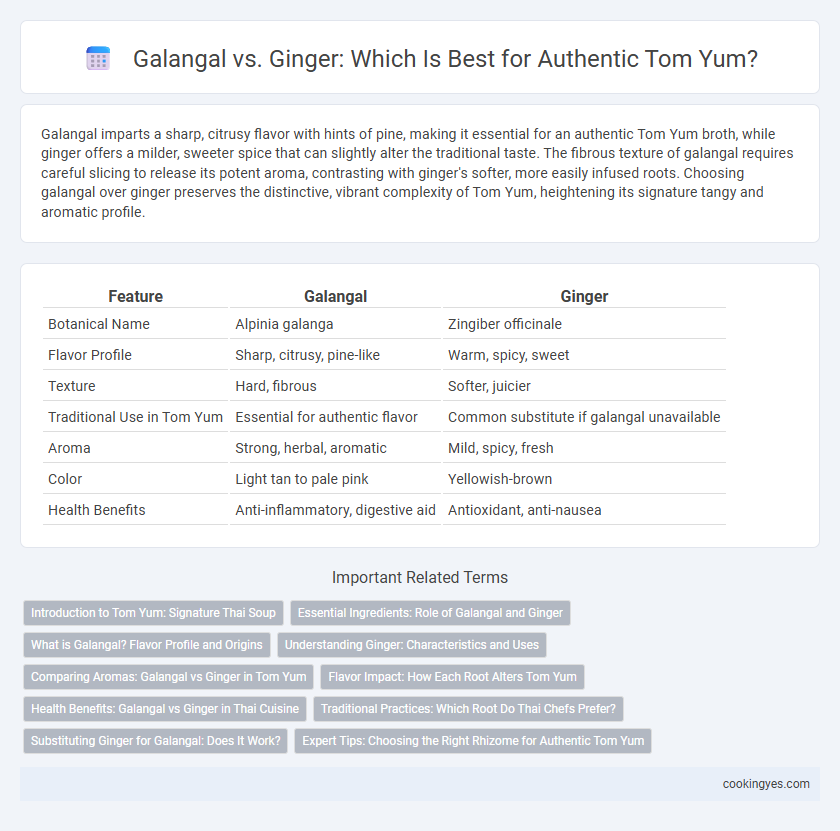Galangal imparts a sharp, citrusy flavor with hints of pine, making it essential for an authentic Tom Yum broth, while ginger offers a milder, sweeter spice that can slightly alter the traditional taste. The fibrous texture of galangal requires careful slicing to release its potent aroma, contrasting with ginger's softer, more easily infused roots. Choosing galangal over ginger preserves the distinctive, vibrant complexity of Tom Yum, heightening its signature tangy and aromatic profile.
Table of Comparison
| Feature | Galangal | Ginger |
|---|---|---|
| Botanical Name | Alpinia galanga | Zingiber officinale |
| Flavor Profile | Sharp, citrusy, pine-like | Warm, spicy, sweet |
| Texture | Hard, fibrous | Softer, juicier |
| Traditional Use in Tom Yum | Essential for authentic flavor | Common substitute if galangal unavailable |
| Aroma | Strong, herbal, aromatic | Mild, spicy, fresh |
| Color | Light tan to pale pink | Yellowish-brown |
| Health Benefits | Anti-inflammatory, digestive aid | Antioxidant, anti-nausea |
Introduction to Tom Yum: Signature Thai Soup
Galangal and ginger both play crucial roles in crafting the signature flavor of Tom Yum, the iconic Thai soup known for its bold, aromatic profile. Galangal offers a sharper, citrusy taste that defines the authentic spicy and sour character essential to Tom Yum, while ginger provides a milder, warming undertone that complements but does not overpower the soup's vibrant essence. Using galangal preserves the traditional essence of Tom Yum, ensuring the dish maintains its distinct balance of spicy, sour, and fragrant notes treasured in Thai cuisine.
Essential Ingredients: Role of Galangal and Ginger
Galangal and ginger are essential ingredients that define the signature flavor of Tom Yum soup, each contributing distinct aromatic profiles. Galangal provides a sharp, citrusy, and slightly pine-like taste that enhances the soup's complexity and balances the spiciness, while ginger offers a warm, peppery undertone that adds depth and subtle sweetness. The combination of galangal's bright zest and ginger's spicy warmth creates the essential harmony that characterizes authentic Tom Yum.
What is Galangal? Flavor Profile and Origins
Galangal, a rhizome native to Southeast Asia, is a key ingredient in authentic Tom Yum soup, distinct from ginger due to its sharp, citrusy, and pine-like flavor profile. Unlike ginger's spicy warmth, galangal imparts a bright, slightly peppery taste that enhances the soup's aromatic complexity. Originating from Thailand and Indonesia, galangal is prized for its unique fragrance and medicinal properties, making it indispensable in traditional Thai cuisine.
Understanding Ginger: Characteristics and Uses
Ginger, a rhizome with a spicy, warming flavor, imparts a subtle zest to Tom yum without overpowering other ingredients. Its fibrous texture and sharp, citrusy notes complement the broth's sour and spicy profile, enhancing depth and complexity in each spoonful. Widely used in Asian cuisine, ginger also offers digestive benefits, making it a functional and flavorful component in Tom yum recipes.
Comparing Aromas: Galangal vs Ginger in Tom Yum
Galangal in Tom Yum delivers a sharp, citrusy aroma with hints of pine and pepper, creating a distinctive fragrance that defines the soup's flavor profile. Ginger, while adding warmth and a slight sweetness, offers a more familiar and less intense scent that can soften the soup's overall aromatic complexity. Choosing galangal over ginger emphasizes the traditional, bold scent essential to authentic Tom Yum, whereas ginger imparts a milder, more approachable fragrance.
Flavor Impact: How Each Root Alters Tom Yum
Galangal imparts a sharp, citrusy, and slightly pine-like flavor that is essential to achieving the authentic Thai taste in Tom Yum soup. Ginger, while similar in appearance, offers a sweeter, warmer, and more peppery flavor that alters the traditional profile, making the broth less tangy and aromatic. Using galangal instead of ginger preserves the soup's bright, zesty character, which is critical for the classic balance of sour, spicy, and savory notes.
Health Benefits: Galangal vs Ginger in Thai Cuisine
Galangal and ginger both offer unique health benefits in Tom Yum soup, with galangal rich in anti-inflammatory properties and antioxidants that support digestion and immune health. Ginger provides strong anti-nausea effects and aids in reducing muscle pain and inflammation, making it a versatile ingredient in Thai cuisine. While galangal enhances respiratory function and combats bacterial infections, ginger contributes to cardiovascular health and blood sugar regulation, complementing each other's healing qualities in traditional dishes.
Traditional Practices: Which Root Do Thai Chefs Prefer?
Thai chefs traditionally prefer galangal over ginger for Tom Yum due to its distinct citrusy and pine-like aroma that defines the soup's authentic flavor profile. Galangal's firm texture and sharp, earthy notes contribute to the complexity and balance of Tom Yum, whereas ginger's sweetness is less prominent in classic recipes. This preference reflects centuries of culinary practice rooted in preserving genuine Thai taste and aromatic integrity.
Substituting Ginger for Galangal: Does It Work?
Substituting ginger for galangal in Tom Yum soup alters the flavor profile significantly, as galangal provides a sharp, citrusy, and pine-like taste essential to authentic Thai cuisine. Ginger's warmer, spicier notes lack the unique aromatic complexity of galangal, which can result in a less vibrant and slightly sweeter broth. While ginger can be used in a pinch, true Tom Yum aficionados prefer galangal to maintain the soup's characteristic balance of bright and earthy flavors.
Expert Tips: Choosing the Right Rhizome for Authentic Tom Yum
Galangal offers a sharper, citrusy flavor essential for authentic Tom Yum, while ginger provides a milder, sweeter profile that can alter the traditional taste. Experts recommend using fresh galangal rhizomes, sliced thinly to release its pungent aroma, ensuring the soup's signature bright and spicy character. Substituting ginger may be suitable for those seeking a less intense flavor but compromises the dish's genuine Thai essence.
Galangal vs Ginger for Tom yum Infographic

 cookingyes.com
cookingyes.com